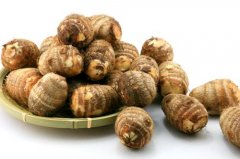How many days is the growth period of taro? The planting method and management of taro when to plant taro
How many days is the growth period of taro? The general growth period of taro is 210 to 240 days, and that of late-maturing varieties is 270 to 300 days. If you look at it this way, the growth cycle of taro is very long. Do you want to know the planting method and management of taro and when to grow taro? Let's take a look at it.
Taro is usually planted in February. During the growth of taro, there are usually five leaves, which are mixed with old leaves and new leaves. Taro grows taller in the first three to four months of planting, and becomes shorter in the next three to four months. The planting period will vary with different planting methods, the planting period of the general customary agricultural law is about 8 months, if the organic planting method is used, the planting period will be extended to about 10 months.

How to judge the growth of taro in the process of planting can generally tell the current size of taro from the thickness of the taro stalk (the ratio of the two is about 1:1). In addition, taro is often harmed by many diseases and insect pests, such as blight, the main symptom of which is the decay of leaves, while the common pests are shrimp shell moth and nocturnal moth, whose larvae eat taro leaves and taro stalks. The way of prevention and control is to use sex to attract and kill male adults. In the application of fertilizer, because taro needs a large amount of fertilizer, it is suggested that a small amount of more fertilizer should be applied every week. When the taro is planted to the later stage, it is necessary to pay attention to the characteristic that it requires less water. At this time, the water in the taro field must be drained to avoid damaging the taro corm.
If the planted taro is water taro, we must pay attention to the harm of longevity snail. Fushou snail will directly eat the stalks and leaves of taro. Bitter tea meal can be used to prevent . The principle is that the saponine produced by bitter tea meal can kill organisms in the water (the disadvantage is that it will also kill other innocent aquatic organisms).
- Prev

How many days is the growth period of taro? How to grow taro in water? Planting method of water taro
Taro is a kind of edible plant, which mainly eats its root. This kind of vegetable is also in great demand. Taro belongs to the Araceae family and likes a warm climate. If the temperature is too low, it is not suitable for the growth of taro. The general planting time of taro is
- Next

When is the best time to plant taro? Do you make money by growing taro? Taro planting costs and benefits
Taro cultivation is basically no season, most of the planting here in spring and summer, as for the so-called ramet is only said to transplant, then basically as long as the choice of budding can be planted, and from planting to harvest can be at least 2-3 months. Base
Related
- The first cup of black tea in spring, the flavor and history of tea gardens in Kenya, Africa
- The computer can not only choose potatoes, but also grow tea rice. AI will grow winter oolong tea champion.
- It is not only the inflated tea bitten by insects, but also engraved with the four seasons tea in Beipu.
- The Oriental Beauty Tea Festival in Zhuxian County takes the stage at the weekend to experience the plus-size feast of oil tea.
- & quot; Oriental Beauty Tea & Exploration of Emei in Hsinchu, the hometown of quot;
- The new variety of strawberry "Tainong 1" dessert is the first choice with mellow aroma. Crimson gorgeous
- History of Tea in Taiwan: from Wild Inner Mountain to Export Tea Garden
- Two types of Taiwan Oriental Beauty Black Tea won the British three-Star Award for Childhood Tea Xiang Zhang Jiaqi changed from pilot to champion tea maker.
- Banana species and varieties: the planting history of Taiwan Xianren banana and dwarf banana is long, is banana disease resistant?
- Coffee planting Technology: Qianjie Coffee from Seedling to harvesting

